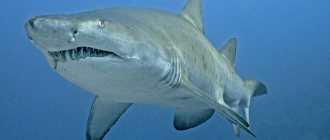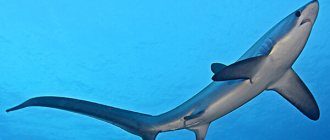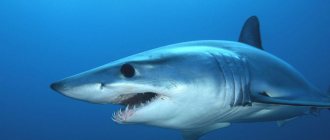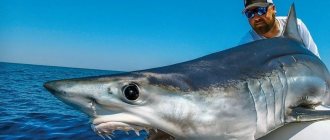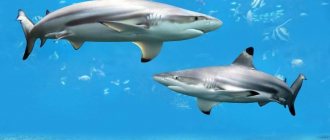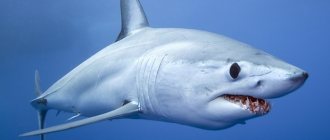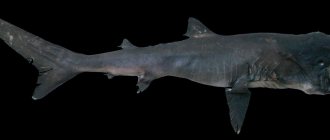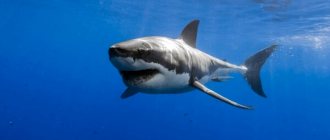- Wild animals
- >>
- Fish
shark Megalodon climbed to the top of the food chain . The only nuance was that his possessions were located not on land, but in the World Ocean. The species existed in the Pliocene and Miocene eras, although some scientists cannot come to terms with this and believe that it could have survived to this day.
Origin of the species and description
Photo: Megalodon shark
Carcharocles megalodon is a species of extinct shark belonging to the family Otodontidae. Translated from Greek, the name of the monster means “big tooth.” According to the findings, it is believed that the predator appeared 28 million years ago and died out about 2.6 million years ago.
Interesting fact: The predator's teeth are so huge that for a long time they were considered the remains of dragons or huge sea serpents.
In 1667, scientist Niels Stensen put forward a theory that the remains were nothing more than the teeth of a giant shark. In the mid-19th century, megalodon established itself in a scientific classification under the name Carcharodon megalodon due to the similarity of its teeth to those of the great white shark.
Video: Megalodon Shark
In the 1960s, the Belgian naturalist E. Cazier transferred the shark to the genus Procarcharodon, but soon the researcher L. Glickman assigned it to the genus Megaselachus. The scientist noticed that sharks have two types of teeth - with and without serrations. Because of this, the species moved from one genus to another until, in 1987, the French ichthyologist Capetta assigned the giant to its current genus.
Previously it was believed that the predators were similar in appearance and behavior to white sharks, but there is reason to believe that due to their enormous size and separate ecological niche, the behavior of megalodons was very different from modern predators, and their appearance was more similar to a giant copy of the sand shark .
Scientific classification
| Domain | Eukaryotes |
| Kingdom | Animals |
| Type | Chordata |
| Class | Cartilaginous fish |
| Family | Otodontidae |
| Genus | Carcharocles Jordan, 1923 |
| View | Megalodon |
| International scientific name | Carcharocles megalodon (Agassiz, 1843) |
Appearance and features
Photo: Big megalodon shark
Most of the information about the underwater inhabitant is obtained from its found teeth. Like other sharks, the giant's skeleton consisted not of bones, but of cartilage. In this regard, very few remains of sea monsters have survived to this day.
The teeth of the basking shark are the largest of all fish. They reached 18 centimeters in length. None of the underwater inhabitants can boast of such fangs. They are similar in shape to the teeth of a white shark, but three times smaller. The whole skeleton has never been discovered, only its individual vertebrae. The most famous discovery was made in 1929.
The found remains make it possible to judge the size of the fish as a whole:
- length - 15-18 meters;
- weight - 30-35 tons, maximum up to 47 tons.
According to its estimated size, megalodon was on the list of the largest aquatic inhabitants and stood on a par with mosasaurs, deinosuchus, pliosaurs, basilosaurs, hainosaurs, kronosaurs, purussaurs and other animals whose sizes are larger than any living predators.
The animal's teeth are considered the largest among all sharks that have ever lived on Earth. The jaw was up to two meters wide. The mouth had five rows of powerful teeth. Their total number reached 276 pieces. The inclined height could exceed 17 centimeters.
The vertebrae have survived to this day thanks to a high concentration of calcium, which helped support the weight of the predator during muscle loads. The most famous spinal column found consisted of 150 vertebrae with a diameter of up to 15 centimeters. Although in 2006 a spinal column was found with a much larger vertebral diameter - 26 centimeters.
Where does the megalodon shark live?
Photo: Ancient megalodon shark
Fossil remains of the giant fish are found throughout, including the Mariana Trench at a depth of more than 10 kilometers. Its widespread distribution indicates that the predator is well adapted to any conditions except cold regions. The water temperature fluctuated around 12-27 °C.
Shark teeth and vertebrae were found at different times in many regions of the planet:
- Europe;
- South and North America;
- Cuba;
- New Zealand;
- Australia;
- Puerto Rico;
- India;
- Japan;
- Africa;
- Jamaica.
In Venezuela, there are known finds in fresh water, which allows us to judge the adaptability of being in fresh water bodies, like a bull shark. The oldest reliable finds date back to the Miocene era (20 million years ago), but there is also news of remains from the Oligocene and Eocene eras (33 and 56 million years ago).
The inability to establish a clear time frame for the existence of the species is due to the uncertainty of the boundary between megalodon and its putative ancestor Carcharocles chubutensis. This was due to the gradual change in the characteristics of teeth during evolution.
The period of extinction of the giants falls on the boundary of the Pliocene and Pleistocene, which began about 2.5 million years ago. Some scientists put the figure at 1.7 million years ago. Relying on the theory of the rate of growth of sediment crusts, researchers obtained ages of thousands and hundreds of years ago, but due to different rates of growth or its cessation, this method is unreliable.
Introduction
Sharks. These ancient creatures arouse interest among people, mixed with a feeling of unconscious fear. There are more myths and legends about sharks than about any other sea creatures. It is believed that they are the most advanced predators on our planet. Having reached the limit in the development of predatory fish, they have remained unchanged for hundreds of millions of years. The imagination of writers and screenwriters is fueled by stories about their attacks on people. And enthusiasts dream of finding the most dangerous predator, megalodon, in the depths of the sea. Today we will go back to the distant past and, together with sharks, will go through the thorny path of their evolution.
What does the megalodon shark eat?
Photo: Megalodon shark
Before the appearance of toothed whales, super-predators occupied the top of the food pyramid. They had no equal in obtaining food. Their monstrous size, powerful jaws and huge teeth allowed them to hunt large prey that no modern shark could handle.
Interesting fact: Ichthyologists believe that the predator had a short jaw and did not know how to tightly capture the victim and dismember it, but only tore off pieces of skin and superficial muscles. The giant's feeding mechanism was less efficient than that of, for example, a mosasaurus.
Fossil remains with traces of shark bites make it possible to judge the giant’s diet:
- sperm whales;
- cetotherium;
- bowhead whales;
- minke whales;
- walrus dolphins;
- turtles;
- porpoises;
- sirens;
- pinnipeds;
- Odobenocetops.
Megalodon fed mainly on animals ranging in size from 2 to 7 meters. These were mainly baleen whales, whose speed was low and they could not resist sharks. But despite this, the megalodon still needed a hunting strategy to catch them.
Many whale remains showed bite marks from a huge shark, and some of them even had giant teeth sticking out. In 2008, a group of ichthyologists calculated the force of the predator's bite. It turned out that he squeezed the victim with his teeth 9 times stronger than any modern fish and 3 times more powerful than a saltwater crocodile does.
Age of Lizards
The restoration of the biosphere after the Great Permian Extinction proceeded very quickly. The liberation of many ecological niches spurred evolution, and sharks did not stand aside. But not only them. A sharp reduction in the number of large aquatic predators allowed reptiles to switch to an aquatic lifestyle. Primitive ichthyosaurs appeared already in the Early Triassic. Somewhat later, nothosaurs went to sea to give birth to plesiosaurs. Of the archosaurs, crocodylomorphs stand out, and by the Jurassic period, some of them also mastered the sea element. The seas are becoming the scene of intense competition between sharks and reptiles, in which bony fish largely remain the role of prey.
During the evolutionary race, pelagic sharks acquire their modern appearance. An ideal body shape, a large mouth with a movable upper jaw, an excellent sensory system, viviparity in some species - these features allow sharks to compete with ichthyosaurs on equal terms. And their sharp teeth, changing like on a conveyor belt, cause much more dangerous injuries. Gradually, sharks begin to displace reptiles from the ecological niches of medium-sized predators, but remain in the shadow of the giants. How intense the struggle was can be judged by the following fact. In the mid-Cretaceous period, as a result of the Cenomanian-Turonian extinction, ichthyosaurs went extinct. And immediately a replacement appears - large sharks from 6 to 10 meters long (Ptychodus mortoni, etc.).
Already in the Jurassic period, representatives of those orders of sharks that exist today appeared - carchariformes, lamniformes and others. The mass extinction at the end of the Cretaceous period brings an end to the century of dominance of reptiles, both on land and in the seas. Even mosasaurs, those highly successful relatives of monitor lizards that conquered the ocean at the end of the Cretaceous, do not survive. Losses among cartilaginous animals (including sharks) amounted to only 20% of species. Sharks are entering a new era as the absolute masters of the sea elements.
Features of character and lifestyle
Photo: Big megalodon shark
Basically, sharks attack their prey in vulnerable places. However, the megalodon had slightly different tactics. The fish first rammed its prey. In a similar way, they broke the victim’s bones and caused damage to internal organs. The prey lost the ability to move and the predator calmly ate it.
Especially large prey fish had their tails and fins bitten off so that they could not swim away, and then killed. Due to their weak endurance and low speed, megalodons could not pursue their prey for a long time, so they attacked it from an ambush, without risking a long pursuit.
In the Pliocene era, with the advent of larger and more developed cetaceans, the sea giants had to change their strategy. They rammed specifically into the chest to damage the victim's heart and lungs, and the upper part of the spine. Fins and flippers were bitten off.
A very common version is that large individuals, due to their slow metabolism and lower physical strength than young animals, ate more carrion and did little active hunting. Damage on the found remains could indicate not the tactics of the monster, but the method of extracting internal organs from the chest of dead fish.
Holding even a small whale while biting it in the back or chest would be extremely difficult. It would be simpler and more logical to attack prey in the stomach, as modern sharks do. This is confirmed by the great strength of the teeth of adult sharks. The teeth of the juveniles were more reminiscent of the teeth of today's white sharks.
First blood
The history of sharks begins in ancient times, at a time when the only vertebrates on the planet were fish. Forced to defend themselves from cephalopods and crustacean scorpions, they dressed themselves in powerful armor. These armored creatures, ostracoderms, did not have jaws. They fed on detritus and invertebrates, filtering bottom mud. But by the middle of the Silurian period the situation changed. The ossified gill arches formed the jaws, and the scales covering them turned into teeth. The prey has become an active predator.
By the beginning of the Devonian period, the following evolutionary branches of fish took shape: - acanthodes and placoderms, now extinct; - bony fishes, which will be divided into ray-finned and lobe-finned; - cartilaginous, represented by sharks, rays and chimeras.
The first fossils of cartilaginous fish date back 400 million years, and they are, of course, represented by teeth. It is the teeth that will mark the entire path of the further evolutionary history of sharks. You could even say that their history is the history of teeth.
What do human teeth, shark teeth, and placoid scales have in common? Same structure. Placoid scales are the most ancient. It is a diamond-shaped plate of dentin embedded in the skin. The protruding spike is covered with vitrodentin (essentially tooth enamel), and the internal cavity of the scale is filled with pulp with blood vessels. Even in the Devonian, such formations became the first teeth of fish, both sharks and our ancestors. The smooth spike of the scale protruding from the skin has turned into the working part of the tooth. It was not fixed in the bone and was easily lost, but a new tooth grew in its place.
About 370 million years ago, Cladoselachidae emerged from the diversity of cartilaginous fish. These fish lived in shallow seas on the site of the future North America. They were the first fish to bear the basic structural features of sharks. The elongated, spindle-shaped body reached 1.8 m in length, and ended in a tail with identical upper and lower blades. The skin, unlike modern sharks, was almost devoid of scales. The horseshoe-shaped mouth on the lower part of the head was dotted with smooth teeth with several peaks. Five to seven gill slits ensured the flow of water to the gills. We know all this thanks to the well-preserved skeletons of cladoselachians with imprints of organs and tissues. It seems paradoxical, but the first sharks were cartilaginous only formally. And sharks still have genes responsible for the formation of bone tissue today.
Social structure and reproduction
Photo: Ancient megalodon shark
There is a theory that megalodon became extinct during the appearance of the Isthmus of Panama. During this period, the climate changed and warm currents changed directions. It was here that a cluster of giant baby teeth was found. The sharks bred in shallow waters and the babies lived here for the first time of their lives.
In the entire history it was not possible to find a single place like this, but this does not mean that it does not exist. Not long before this, a similar find was discovered in South Carolina, but these were the teeth of adult individuals. The similarity between these discoveries is that both places were above sea level. This means that sharks either lived in shallow waters or came here to breed.
Before this discovery, researchers argued that the baby giants did not need any protection, because they are the largest species on the planet. The findings confirm the hypothesis that the young animals lived in shallow water in order to be able to protect themselves, because two-meter babies could easily become prey for another large shark.
It is assumed that at a time the huge underwater inhabitants could give birth to only one baby. The cubs were 2-3 meters long and attacked large animals immediately after birth. They hunted herds of sea cows and grabbed the first one they came across.
Natural enemies of megalodon sharks
Photo: Giant shark megalodon
Despite its status as the highest link in the food chain, the predator still had enemies, some of them were its food competitors.
Researchers list them as:
- predatory schooling mammals;
- killer whales;
- toothed whales;
- some large sharks.
The killer whales that emerged as a result of evolution were distinguished not only by their strong bodies and powerful teeth, but also by their more developed intelligence. They hunted in packs, which caused the megalodon's chances of survival to drop significantly. Killer whales, in their characteristic manner of behavior, attacked young animals in groups and ate the cubs.
Killer whales were more successful at hunting. Thanks to their speed, they ate all the large fish in the ocean, leaving no food for the megalodon. The killer whales themselves escaped from the fangs of the underwater monster with the help of their dexterity and intelligence. Together they could kill even adults.
The underwater monsters lived in a favorable period for the species, since there was practically no food competition, and the ocean was inhabited by a large number of slow, undeveloped whales. When the climate changed and the oceans became colder, their main food disappeared, which was the main reason for the extinction of the species.
The scarcity of large prey led to constant hunger for giant fish. They searched for food as desperately as possible. In times of famine, cases of cannibalism became more frequent, and during the food crisis in the Pliocene era, the last individuals exterminated themselves.
Extinction
The reason for the extinction of the predator is not fully known. Scientists have several hypotheses for the extinction of megalodon.
- Decrease in water temperature of the world's oceans. 15-17 million years ago, glaciations in the northern hemisphere and blocking of the sea strait between North and South America led to a decrease in temperature on the planet. Growing glaciers also led to a drop in the water level of the world's oceans. Fossil remains confirm that as water levels dropped and temperatures dropped, the megalodon's habitat moved to warmer regions. The breeding and feeding grounds of basking sharks were also affected.
- Hunger. By the end of the Miocene, most species of baleen whales became extinct. Namely, baleen whales constituted the main diet of megalodon. The surviving species of whales were better adapted to existing habitat conditions, were faster and preferred cool waters. It was difficult for the megalodon to hunt them, and there was no suitable prey to satisfy its colossal appetite.
- Competition with predatory whales. The appearance of schooling predatory mammals that successfully competed with megalodon. The famous killer whales turned out to be more successful hunters. They were faster, hunted all large sea animals, and they themselves were practically invulnerable due to their great speed and intelligence.
Scientists believe that all three factors led to the death of the giant. Cooling of the ocean and lack of nutrition played a significant role in the death of the megalodon, and against the background of this, newly emerging predators finally replaced the significantly thinned ranks of megalodons.
